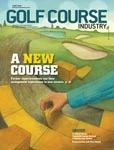In the world of golf course management, there really isn’t anything like the GCSAA conference and show. I was lucky to attend 37 of them consecutively, from Boston in 1973 through New Orleans this year.
Most states also offer a turf conference and/or a show. Here in Wisconsin we have the WGCSA Golf Turf Symposium in the fall, the Wisconsin Turfgrass Association Green Expo in the winter, and the WTA Summer Field Day. I never miss these.
There are some regional turf conferences that are simply outstanding, as well. Ohio, the Carolinas and New England are ones I’m familiar with. The New England conference is one I’ve attended regularly over the past 25 years, and I went to Providence, R.I., again this past March. The program this year has some special appeal to me.
The first half-day session on Tuesday was the USGA Green Section presentation, and one of the speakers was Adam Moeller, a Green Section agronomist. He’s a Wisconsin alum from Dr. John Stier’s program (2005) and worked on our golf course in 2004. Add to that his five seasons at Sheboygan Town and Country, a season at Blackwolf Run in Kohler and a master’s degree from Purdue (2006-2008) in Cale Bigelow’s turf program, and you have an agronomist who’s going to offer many years of service to golf courses wherever he serves. I felt like a proud parent that day he spoke.
That’s the Green Section for you. Quality, dependable and unbiased advice about golf course issues starts and ends with quality people. When hired, Moeller had great potential; after training by people like Dave Otis, Jim Skorulski, Stan Zontek and Darin Bevard, he is very well prepared for his responsibilities as a Northeast Region agronomist.
The state of our nation’s economy has been tough on golf; it’s been a period of decreasing rounds and diminished revenue. Golf course superintendents are scratching hard to reduce expenses without sacrificing quality playing conditions.
I contend this is exactly the best time to enlist the Green Section Turf Advisory Service, whether your course is a long-time subscriber or a potential first-timer. It always has been a great bargain, and it is more so today.
The agronomists bring a wealth of information with them when they visit your course. Moeller, for example, visited more than 100 golf courses last year, his first. Imagine what veteran agronomists have seen in their long careers. They make about 2,000 total golf course visits each year; their combined experiences and observations are invaluable to golf course superintendents who access them. Although only an agronomist from your region visits, you are potentially getting input from all 18 of them due to their extensive networking activities.
The actual visit can take on any format that suits your course. They’ll come for a morning green committee meeting or visit in the afternoon and attend an evening board meeting, if you want. They’ll come whenever an unplanned emergency arises. We’ve had visits in every season to give a different perspective to the course.
I would enjoy the conversations we’d have, always appreciating the logic behind a different point of view.
The visit itself is worth the cost ($3,100 full day/$2,300 half day with early sign-up discounts available), but the written reports bring even more value to a TAS subscription. I’ve seen the report posted in the locker rooms. Other times it was distributed to the board, the green committee or both. We had on file the continuous history of the Green Section visits to our club. Rereading them for reminders of past advice or for reinforcement of some idea was helpful at times.
I like to reflect back on the good advice I’ve received from TAS agronomists – F. Lee Record, Carl Schwartkopf, Stan Zontek, James Latham and Bob Vavrek, and wonder what I’d done without their help.
My good friend Joel Jackson of the Florida GCSA recently made an excellent case for not cutting golf course travel and educational spending. I think of TAS visits the same way. In the financial scheme of operating a golf course, the subscription fee is relatively modest and the potential payoff in good advice is substantial.
And who knows – if you’re in the Northeast Region, maybe you could get Moeller to stop by. GCI

Explore the June 2009 Issue
Check out more from this issue and find your next story to read.
Latest from Golf Course Industry
- From the publisher’s pen: Conscientious of a bigger role
- Bernhard and Company partners with Laguna Golf Phuket
- Terre Blanche showcases environmental stewardship
- VIDEO: Introducing our December issue
- Bernhard and Company introduces Soil Scout
- Nu-Pipe donates to GCSAA Foundation’s Centennial Campaign
- GCSAA enhances golf course BMP tool
- Melrose leadership programs sending 18 to 2026 GCSAA Conference and Trade Show





